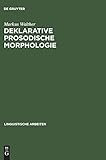Deklarative prosodische Morphologie : Constraint-basierte Analysen und Computermodelle zum Finnischen und Tigrinya / Markus Walther.
Material type: TextSeries: Linguistische Arbeiten ; 399Publisher: Berlin ; Boston : De Gruyter, [2017]Copyright date: ©1999Edition: Reprint 2017Description: 1 online resource (VII, 295 p.) : Zahlr. AbbContent type:
TextSeries: Linguistische Arbeiten ; 399Publisher: Berlin ; Boston : De Gruyter, [2017]Copyright date: ©1999Edition: Reprint 2017Description: 1 online resource (VII, 295 p.) : Zahlr. AbbContent type: - 9783484303997
- 9783110911374
- Constraints (Linguistics)
- Gemination
- Grammar, Comparative and general -- Morphology
- Grammar, Comparative and general -- Phonology
- Prosodic analysis (Linguistics)
- Tigrinya language -- Gemination
- Tigrinya language -- Morphology
- Tigrinya language -- Prosodic analysis
- Tigrinya language -- Verb
- Constraint-logische Programmierung
- Finnisch
- Morphologie ‹Linguistik›
- Prosodie
- Tigrinja-Sprache
- LANGUAGE ARTS & DISCIPLINES / Linguistics / General
- 494/.54115
- P241.W35 1999
- online - DeGruyter
- Issued also in print.
| Item type | Current library | Call number | URL | Status | Notes | Barcode | |
|---|---|---|---|---|---|---|---|
 eBook
eBook
|
Biblioteca "Angelicum" Pont. Univ. S.Tommaso d'Aquino Nuvola online | online - DeGruyter (Browse shelf(Opens below)) | Online access | Not for loan (Accesso limitato) | Accesso per gli utenti autorizzati / Access for authorized users | (dgr)9783110911374 |
Frontmatter -- Inhaltsverzeichnis -- Danksagung -- Kapitel 1. Einleitung -- Kapitel 2. Theoretische und formale Grundlagen -- Kapitel 3. Geminaten und Ambisilbizität -- Kapitel 4. Constraintbasierte prosodische Morphologie -- Kapitel 5. Prosodische Morphologie der Verben in Tigrinya -- Kapitel 6. Zusammenfassung und Ausblick -- Literatur -- Anhang
restricted access online access with authorization star
http://purl.org/coar/access_right/c_16ec
Dieses Buch behandelt die deklarative Analyse von prosodischer, insbesondere silbenbasierter Morphologie mithilfe unverletzbarer Constraints. Nach der Einleitung führt Kapitel 2 zunächst in das theoretische Paradigma der Deklarativen Phonologie und die formalen Grundlagen ein. Kapitel 3 beschäftigt sich mit Prosodie auf der Ebene der Einzellaute in Gestalt einer neuen, linguistisch adäquaten Repräsentation für Doppelkonsonanten, die ohne multiple Assoziation auskommt. Zunächst wird potentielle Ambisilbizität als die definierende Geminateneigenschaft bestimmt. Mithilfe einer Merkmalszerlegung von Silbenrollen kann diese dann lokal an einer einzigen Segmentposition repräsentiert werden. Eine computerimplementierte Detailstudie zu Konsonantenalternationen im Finnischen belegt die Durchführbarkeit des Vorschlags. Die Hauptkapitel 4 und 5 behandeln wortbasierte Prosodie mit dem Schwerpunkt auf 'nichtkonkatenativen' Wurzel-Vokalmuster-Morphologien. Da eine template-basierte Forminvarianz unvereinbar mit der empirischen Formvarianz ist, wird letztere durch systematische Vokal-Null-Alternation in konkatenativen Repräsentationen formalisiert. Silbenstruktur-Constraints lizensieren dann mögliche Formen. Eine inkrementelle Optimierung als universales Performanzprinzip präferiert zudem ein zeitlich frühes Weglassen alternierender Vokale. Auch hier belegt ein Computermodell aller 410 Verbformen im äthiosemitischen Tigrinya die Anwendbarkeit der Theorie im Detail.
This volume covers the declarative analysis of prosodic morphology using inviolable constraints. In this context, syllable-based restrictions not only govern individual segmental alternations but also influence the surface shape of entire word forms. Starting with theoretical and formal foundations within the framework of computational phonology, the book then develops novel theories of the both geminate representation and the analysis of 'non-concatenative' morphologies. The theories receive application via two computational in-depth studies of consonant alternations in Finnish and Tigrinya verbs.
Issued also in print.
Mode of access: Internet via World Wide Web.
In German.
Description based on online resource; title from PDF title page (publisher's Web site, viewed 28. Feb 2023)


